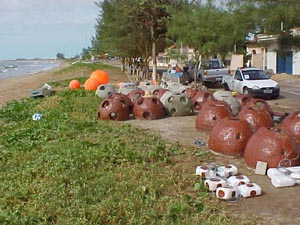 |
 |
Project: COLONIZATION AND SUCCESSION OF SESSILE BIOTA AND FISHES IN A ARTIFICIAL REEF IN THE NOTH COAST OF RIO DE JANEIRO - BRAZIL (2002 - 2004) - Colonização e sucessão da biota séssil e de peixes em um recife artificial no litoral norte do Estado do Rio de Janeiro, Brasil.
Leader:
Werther Krohling
Collaborators: DS Brotto, MA Peres, S Brum, IR
Zalmon.
Abstract: In
the North coast of Rio de Janeiro, 36 concrete modules (reefballs®) were sunk at
3 miles off the coast of Manguinhos Beach, (21º29 S' / 41º00 W') about 9 meters
deep. Half of those were painted with anti-fouling paint and the other half was
left unchanged. Concrete plates (painted plates and non-painted) were attached
at the reefs. Every month the sessile biota of the different plates as well as
fishes associated with the artificial reef will be
monitored.
Objectives:
1. Determine the composition of the epibenthic
and fish community of the artificial reef along 12 months.
2. Compare monthly variation
(recruitment) and accumulation (succession process) of the epibenthic biota and
ichthyofauna of the two treatments of the artificial reef (i.e. with or without
anti-fouling paint).
Support: FAPERJ - Fundação de Amparo à Pesquisa do Estado do Rio de Janeiro, LCA/UENF.
 |
 |
Artificial reefs (left) and study plates (right) with and withouth antifouling paint.
Project: Occurrence, Abundance and annual variation of Echinodermata in Coastal Marine Environment on Praia da Costa beach, Vila Velha, ES – Brazil - Ocorrência, Abundância e variação anual dos Echinodermata em Ambiente Marinho Litorâneo da Praia da Costa, Vila Velha, ES - Brazil
Leader:
Rodrigo Lopes
Team:
Werther Krohling (adviser)
Abstract: Vila Velha city has many beaches often visited by tourists from every part of Brazil. Echinodermata species are caught to ornamental ends or sold to the tourists as souvenirs (chiefly Oreaster reticulatus, Lytechinus variegatus and Echinaster brasiliensis). The problem becomes worse during summer time, when the snorkeling pratice is utilized by the tourists who take those species from their habitat causing their death. So far, any study has been done at this region in order toaccompany the numerical variation of species and the population density along the year. This study proposes the first survey about Echinodermata species in Coastal Marine Environment on Praia da Costa beach (ES) Brazil, and its sazonal variation along one year of study.
Objectives:
1.
A survey of Echinodermata species on Praia da Costa beach, Vila Velha
ES-Brazil.
2. A study of numerical variation of those species and the
population density along the year.
3. Comparison of Echinodermat species
population densities and their variations in five distinct points on Praia da
Costa beach.